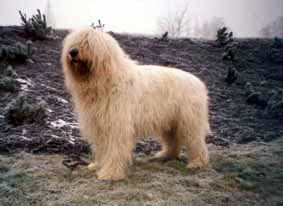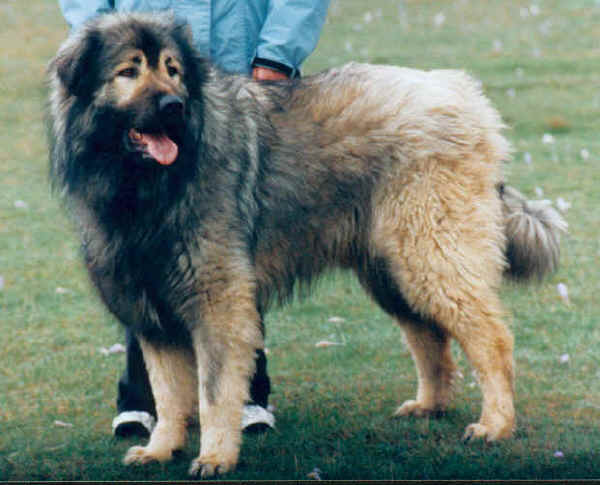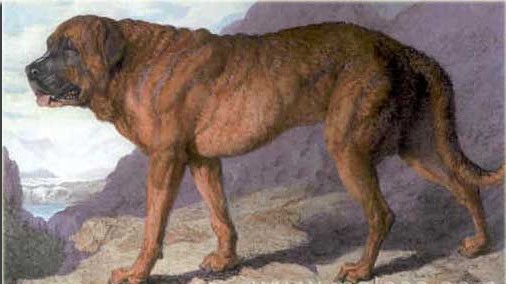Polish Tatra Sheepdog
The Polish Tatra Sheepdog is a large, intelligent breed known for its herding and guarding abilities. With a striking white coat and a loyal temperament, they make excellent companions and watchdogs.
Overview
🐕Breed Overview
✨Key Traits
💡What Makes Polish Tatra Sheepdog Special
The Polish Tatra Sheepdog is characterized by its impressive size and strength, making it a formidable guardian. Their thick, white double coat not only provides insulation but also serves as a visual deterrent against potential threats.
They are highly intelligent, which allows them to assess situations and respond appropriately. Their calm demeanor and loyalty make them excellent companions for families, while their protective instincts ensure they are always on alert.
These dogs excel in roles that require independence and decision-making, making them well-suited for experienced owners who can provide consistent training and socialization. Their ability to adapt to family life while maintaining their guarding instincts sets them apart from other breeds.
The Polish Tatra Sheepdog, also known as the Owczarek Podhalanski, is a majestic breed that hails from the Tatra Mountains of Poland. Renowned for their impressive size and striking white coat, these dogs have been cherished companions and guardians for centuries. With a height ranging from 24 to 28 inches and weighing between 80 to 130 pounds, they possess a robust build that reflects their strength and resilience.
Historically bred for herding and guarding livestock, the Tatra Sheepdog has developed a strong instinct to protect their flock, often remaining vigilant and alert against potential threats. Their gentle demeanor makes them excellent family companions, although they may be reserved around strangers. While they are not aggressive, their loud bark serves as an effective deterrent against intruders.
Training a Polish Tatra Sheepdog requires patience and consistency, as they are known for their independent nature. Early socialization is crucial to ensure they grow into well-rounded adults. With a moderate exercise requirement, these dogs thrive in homes with ample outdoor space where they can roam and explore.
Their grooming needs are relatively high due to their thick double coat, which sheds seasonally. Overall, the Polish Tatra Sheepdog is a loyal and intelligent breed that excels in roles as a guardian, herder, and family companion, making them a unique addition to any household.
🎉Fun Facts
The Polish Tatra Sheepdog is known for its impressive ability to deter predators without engaging them directly.
Their thick double coat helps them withstand harsh weather conditions, making them ideal for mountainous regions.
These dogs have been used in various roles, including as police dogs and personal guards, due to their protective instincts.
Breed Characteristics
Family & Friends
Good Behavior
Get Up & Go
Household Harmony
Temperament & Personality
✨Key Traits
🐕Core Temperament
The Polish Tatra Sheepdog has a temperament that is both protective and gentle. They are loyal to their families and can be very affectionate, although they may not seek constant attention. Their independent nature means they are comfortable spending time alone, but they thrive on companionship and social interaction.
These dogs are generally calm and composed, making them suitable for families with children. However, their protective instincts can lead them to be wary of strangers, so early socialization is essential. They are intelligent and capable of learning commands, but their independent streak may require patience during training.
Overall, they are well-suited for families that appreciate their unique blend of loyalty, intelligence, and protective instincts.
💫Personality Profile
The Polish Tatra Sheepdog is a loyal and intelligent breed known for its protective nature. They are calm and independent, often forming strong bonds with their families. While they can be reserved around strangers, they are generally friendly with other dogs and pets.
Their natural guarding instincts make them vigilant watchdogs, and they will bark to alert their owners of any suspicious activity. Despite their protective nature, they are not aggressive and will only resort to physical action if absolutely necessary. Early socialization is crucial to help them develop a well-rounded personality, as they can be wary of unfamiliar people and situations.
Overall, they are gentle giants that thrive in a loving and structured environment.
🔊Vocal Tendencies
The Polish Tatra Sheepdog is known for its loud and deep bark, which serves as an effective warning system for their families. They tend to bark at anything they perceive as suspicious, making them excellent watchdogs.
While they may not bark excessively, their vocalizations are often loud and commanding, which can be intimidating to intruders. Their barking is typically reserved for alerting their owners to potential threats, and they are less likely to bark for attention or play.
This breed's vocal nature is a reflection of their guarding instincts, and they will use their bark to communicate their concerns to their family.
Affection & Social Traits
Energy & Activity
Communication Style
Care Requirements
🏃♂️Exercise Requirements
Daily Exercise
The Polish Tatra Sheepdog requires a moderate amount of exercise to maintain its physical and mental well-being. Ideally, they need at least 60 to 90 minutes of exercise each day, which can be broken down into multiple sessions. Activities such as long walks, playtime in a secure yard, and engaging in herding or agility exercises are excellent for this breed.
They thrive on mental stimulation, so incorporating puzzle toys or training sessions can also be beneficial. Puppies should have shorter, more frequent exercise sessions to prevent overexertion, while senior dogs may require gentler activities to accommodate their energy levels. Regular exercise helps prevent behavioral issues such as boredom or anxiety, which can lead to destructive behaviors.
Insufficient exercise can result in weight gain and a decrease in overall happiness, so it's crucial to establish a consistent routine.
Preferred Activities
🏠Living & Adaptability
Space Requirements
The Polish Tatra Sheepdog requires ample space to thrive. They are best suited to homes with large, securely fenced yards where they can roam and explore.
While they can adapt to living in a house with a yard, they are not ideal for apartment living due to their size and exercise needs. Owners in smaller living situations should ensure they can provide sufficient outdoor time and mental stimulation to prevent boredom.
The breed's natural guarding instincts mean they may become anxious or destructive if confined to small spaces for extended periods.
Climate Preference
🍲Feeding Guide
Schedule
Food Types
Portion Size
Special Nutritional Needs
The Polish Tatra Sheepdog does not have many specific dietary restrictions, but it is essential to provide a balanced diet rich in protein and healthy fats to support their active lifestyle. Due to their size, monitoring their weight is crucial to prevent obesity.
Some individuals may have sensitivities to certain ingredients, so it's important to choose high-quality dog food with natural ingredients. Regular veterinary check-ups can help assess their nutritional needs as they age.
✨Grooming Requirements
Grooming Overview
The Polish Tatra Sheepdog has a thick double coat that requires regular grooming to keep it healthy and free of mats. Their coat sheds heavily during the spring and fall, necessitating more frequent brushing during these times—ideally, 2-3 times a week.
Outside of shedding seasons, brushing once a week is sufficient. Bathing should be done as needed, typically every few months, or when they become particularly dirty.
Regular nail trimming and ear cleaning are also important to maintain overall hygiene. Their self-cleansing coat helps reduce odors, but regular grooming will keep their coat looking its best and prevent matting.
Care Schedule
Brush 2-3 times a week during shedding seasons; once a week otherwise; bathe every few months or as needed.
Health Profile
⚕️Health Care
Regular health care is essential for the Polish Tatra Sheepdog's longevity. Routine veterinary check-ups, vaccinations, and preventive treatments can help detect health issues early and maintain overall health.
Dental care is also important, as dental disease can lead to other health complications. Owners should establish a health care routine that includes regular vet visits, proper nutrition, and exercise to support their dog's well-being throughout its life.
Health Issues Overview
⏳Average Lifespan
Genetic Factors
Genetics play a significant role in the Polish Tatra Sheepdog's lifespan. Like many large breeds, they can be prone to hereditary health issues, particularly hip dysplasia and certain eye conditions.
Responsible breeding practices that prioritize genetic diversity can help reduce the risk of these health problems. Potential owners should seek reputable breeders who conduct health testing on their breeding stock to ensure the best possible genetic outcomes for their puppies.
Living Conditions
The Polish Tatra Sheepdog's lifespan can be influenced by various environmental factors, including living conditions, climate, and social interactions. Providing a spacious and secure environment allows these dogs to exercise freely, which is crucial for their physical health.
Exposure to harsh weather conditions can affect their well-being, so adequate shelter is necessary. Regular social interactions with family members and other pets can enhance their emotional health, contributing to a longer lifespan.
Ensuring they have a routine that includes physical activity and mental stimulation is vital for promoting longevity.
🏥Common Health Issues
Hip Dysplasia
Warning Signs
🔬Diagnosis
Veterinarians typically diagnose hip dysplasia through physical examinations and X-rays.
💊Treatment
Treatment options include weight management, physical therapy, and in severe cases, surgical intervention.
📝Management Tips
Maintain a healthy weight, provide joint supplements, and engage in low-impact exercises to support joint health.
Progressive Retinal Atrophy (PRA)
Warning Signs
🔬Diagnosis
Diagnosis is usually made through veterinary eye examinations.
💊Treatment
Currently, there is no cure, but supportive care can help manage the condition.
📝Management Tips
Regular veterinary check-ups and monitoring for vision changes are essential.
🛡️Preventive Care
🔬Hip Evaluation
Hip Evaluation assesses the hip joints for dysplasia and other abnormalities, which is crucial for large breeds like the Polish Tatra Sheepdog.
📅 Recommended annually for adults; puppies should be evaluated before breeding.
🔬Ophthalmologist Evaluation
Eye examinations help detect hereditary eye conditions such as Progressive Retinal Atrophy, ensuring early intervention if necessary.
📅 Recommended annually, especially for breeding dogs.
Training
🧠Intelligence & Trainability
💪Work Drive
The Polish Tatra Sheepdog has a strong work drive, stemming from its history as a livestock guardian. They thrive when given tasks to perform, whether it's herding, guarding, or participating in dog sports.
Engaging them in activities that challenge their intelligence and physical abilities is essential for their well-being. Without sufficient mental and physical stimulation, they may become bored and exhibit undesirable behaviors.
Providing them with a job, such as helping with livestock or participating in obedience training, can fulfill their need for purpose and keep them happy.
⚠️Training Considerations
Training the Polish Tatra Sheepdog can present some challenges due to their independent nature and strong-willed temperament. They may not always respond to commands as eagerly as more obedient breeds, which can lead to frustration for inexperienced owners.
Consistent and positive reinforcement training methods are essential to overcome these challenges. Socialization from a young age is crucial to help them become well-adjusted adults.
Engaging them in activities that stimulate their intelligence, such as obedience training or agility courses, can help channel their energy and focus. Owners should be patient and persistent, as this breed may take longer to learn commands compared to others.
📝Training Tips
To effectively train a Polish Tatra Sheepdog, it's important to establish a strong bond based on trust and respect. Start training early, focusing on basic commands and socialization with other dogs and people. Use positive reinforcement techniques, such as treats and praise, to encourage desired behaviors.
Keep training sessions short and engaging to maintain their interest. Incorporating play into training can also be beneficial, as these dogs enjoy interactive activities. Consistency is key; ensure that all family members use the same commands and rules to avoid confusion.
As they are intelligent dogs, providing mental stimulation through puzzle toys or problem-solving games can enhance their training experience.
History & Heritage
📜Origin Story
The Polish Tatra Sheepdog, known locally as the Owczarek Podhalanski, originated in the picturesque Podhale region of southern Poland, nestled in the Carpathian Mountains. This breed was introduced by Vlach shepherds who migrated from Romania, bringing with them their herding dogs.
Over centuries, these dogs adapted to the rugged terrain and harsh weather conditions, developing into the formidable guardians they are today. The breed's primary role has always been to protect sheep from predators, and their instinctual behavior has been honed through generations of selective breeding.
The Tatra Sheepdog's striking white coat not only serves a practical purpose in distinguishing them from predators but also symbolizes their connection to the pastoral lifestyle of the region. As the breed gained popularity, it spread across Europe, although it remains relatively rare, especially outside of Poland.
⏳Development History
The Polish Tatra Sheepdog has a rich history that dates back thousands of years in the Tatra Mountains of Poland. Initially bred by Vlach shepherds, these dogs were developed to guard livestock against predators such as wolves and bears.
Over time, they became known for their intelligence and strong protective instincts. The breed's development was influenced by the harsh mountain environment, leading to their robust physique and thick double coat.
Despite facing near extinction after the World Wars, dedicated breeding efforts in the 1960s helped revive the breed. Today, they are recognized for their unique qualities and continue to serve as both working dogs and loyal companions.
🛡️Purpose & Historical Role
Historically, the Polish Tatra Sheepdog was bred primarily for herding and guarding livestock. Their main role was to deter predators rather than engage them directly, showcasing their intelligence and protective instincts.
They were often left alone with the flock for extended periods, demonstrating their loyalty and ability to assess threats. In addition to herding, these dogs have also served as personal guards and watchdogs, protecting homes and properties.
Their versatility has allowed them to adapt to various roles, including police work and companionship, making them valuable assets to their owners.
🏺Cultural Significance
The Polish Tatra Sheepdog holds a significant place in Polish culture, particularly in the Podhale region where it originated. These dogs have been integral to the lives of shepherds for centuries, serving as both guardians of livestock and companions.
Their presence in folklore and local traditions underscores their importance in rural communities. The breed's ability to protect sheep from predators has made them a symbol of strength and loyalty, and they are often celebrated in local festivals and events.
As a result, the Polish Tatra Sheepdog is not just a working dog but also a cultural icon in Poland.
Conservation Status
This breed is rare and not commonly found outside its region of origin.









